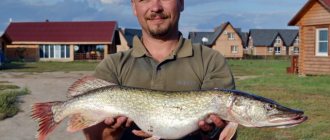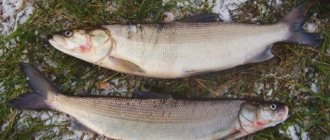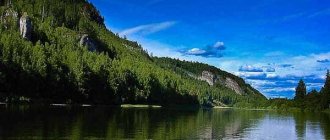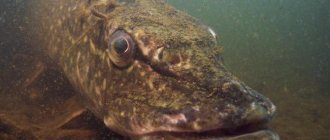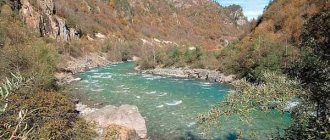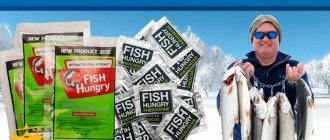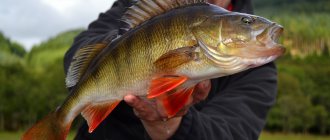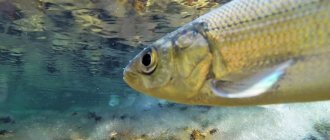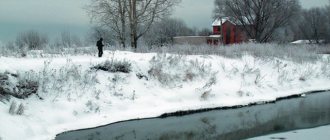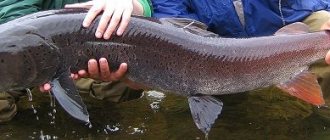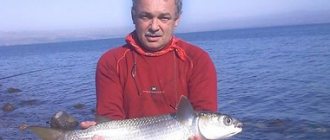Reservoirs of Chukotka
Reservoirs of Chukotka
In Chukotka there are both the familiar fresh and salt lakes. Brackish and saline lakes are located mainly within the northern coastal strip. Freshwater lakes scattered over the entire surface of the region are predominantly of thermokarst origin and are located in groups in the area of tectonic depressions. The largest lakes in Chukotka include Krasnoye and Elgygytgyn. The largest rivers in the region are the Anadyr, Velikaya, Bolshoy and Maly Anyui. The Chukotka rivers are fed primarily by snow and rain. There are known deposits of mineral waters in Chukotka, the temperature of which reaches 80 degrees.
What types of aquatic biological resources are prohibited from catching?
- Fishing in inland water bodies (belonging to the East Siberian fishery basin) located on the territory of the Chukotka Autonomous Okrug is prohibited:
1) nelma;
2) Siberian sturgeon.
- It is prohibited to catch the following aquatic biological resources in the Chukchi Sea and in the Chukchi zone of the Bering Sea:
1) Pacific salmon, with the exception of recreational fishing on tours;
2) spawning Asian toothed smelt;
3) Pacific spawning herring;
4) female crabs of all types;
- Fishing in inland water bodies (belonging to the Far Eastern fishery basin) located on the territory of the Chukotka Autonomous Okrug is prohibited:
1) Pacific salmon, with the exception of recreational fishing on tours;
2) nelma;
3) Boganid paliya;
4) Pilkhykai dalliya;
5) Amguem dalliya;
6) muksuna;
7) Arctic Sea omul;
chira (with the exception of recreational fishing on tours);
9) juvenile Pacific salmon;
10) Beringian omul.
- If prohibited aquatic biological resources are caught, they must be immediately released into their natural habitat with the least damage.
- Fishing for brown trout, palya, omul, and broad whitefish can only be carried out on the basis of permits.
- When carrying out recreational fishing, the collection of kelp, zoster, phyllospadix, capelin and aquatic invertebrates is not prohibited or limited, with the exception of species of aquatic biological resources prohibited from harvesting (catching) from storm discharges.
general information
The main part of the Chukotka Autonomous Okrug is located beyond the Arctic Circle and it is quite natural that the climate in these places is truly harsh, arctic. Winter in Chukotka lasts 10 months. Usually the average temperature in January is 28°C, but often the January temperature can reach -40°C. In July the temperature ranges from +5 to +15°C.
Chukotka is one of those places that seems to have been created by God to test a person’s strength.
This is the land of winds and snowstorms, permafrost, severe frosts, and summer clouds. But at the same time, despite all its severity, this is one of the most beautiful places on the planet. Fishing in the Chukotka Autonomous Okrug
Fishing in Chukotka is a real test of strength, this is exactly what real extreme fishermen need. The rivers and lakes of Chukotka are home to more than 40 species of different fish, many of which are of valuable commercial value. Among them, the most valuable are chinook salmon, coho salmon, pink salmon, sockeye salmon, and chinook salmon. The main species of salmon fishery are sockeye salmon, which lives in the Mainypilgyn lake-river system, and chum salmon from the Anadyr estuary.
Extreme fishing on the territory of Chukotka, in its harsh seas, picturesque rivers and lakes, is an opportunity for real men to realize their potential. There are huge reserves of freshwater fish, such valuable ones as whitefish, whitefish, vendace, valka, and humpback. There are also a lot of grayling, smelt, Dolly Varden, burbot, pike, and Arctic char.
Salmon fishing in Chukotka begins on June 1, as a rule, in the Anadyr region in its southern part in the Khatyrka River. And from June 10, you can catch pink salmon and sockeye salmon in the reservoirs of the Mainypilgyn lake-river system. And from June 20, Putin begins throughout the Anadyr region.
Of course, not only summer fishing pleases fishing enthusiasts. There are many fans of smelt fishing in Chukotka. This small cucumber-smelling fish has a great taste and many people, even entire families, hunt for it when it comes to fishing. In Anadyr at this time there is even a “Smelt Festival”, very beloved by the residents of Chukotka.
In December, when the ice just covers the estuary, the first fishermen begin to appear on it. True, at this time there are very few of them. However, they already exist and their number is gradually increasing every day. Ice fishing in Chukotka in Anadyr begins from the Anadyr seaport. But while the ice is thin and it is impossible to drive on it by car or snowmobile, there are still few people.
But with the onset of January, when the ice is thick enough and can easily withstand equipment, you won’t see anything on the ice of the estuary. There are motor sleighs, all-terrain vehicles with smoking coal stoves, and various homemade products that act as snowmobiles and much more. And all this various equipment is constantly purring with its engines not switched off. There is simply no other way, otherwise it will be very problematic to start the engine, and in most cases it is simply impossible. So, you can forget about silence until spring on local fishing.
The catches at this time are still small and average 20-30 pieces. However, this is a rare, but long-awaited smelt, for which many fishermen come. During this period, the strongest cucumber aroma comes from the smelt. This fish smells stronger of cucumber than cucumber itself.
In February, daylight hours are already noticeably increasing, and fishermen occupy the entire water area of the Anadyr Estuary. They are concentrated mainly along the fairway, at a considerable distance from the city towards the fishing base. Fishing for smelt in the Anadyr Estuary attracts more and more anglers.
However, if a snowstorm begins, and on the estuary this thing is especially treacherous, and it is better to immediately leave the fishing spot and go to the city.
Otherwise, visibility will soon be equal to 0. And then many fishermen who did not manage to leave the estuary in time will have to deal with the Ministry of Emergency Situations. But often even the Ministry of Emergency Situations is unable to find all the unfortunate fishermen who did not have time to leave the fishing spot. However, after the end of the blizzard, it turns out that many fishermen are located almost next to the city. Fishing in Chukotka
Whether there is fish in a particular place can be determined immediately from the shore, by the number of fishermen. So if the bite is very bad or absent altogether, even on weekends there are very few or no fishermen on the estuary. But as soon as the bite intensifies, and the catches exceed 10-12 individuals, the estuary is again covered with fishermen.
March is the real beginning of the fishing season. Smelt fishing in Chukotka is taking on a new quality. Now many people come to the ice of the estuary not only to catch smelt, but also just to relax. Barbecues are smoking and barbecues are roasting everywhere, and a tantalizing barbecue smell hovers over the estuary.
It is at this time that key fishing points are fully established on the estuary. These points are located in completely different places in different years. Such points are named after the places near which they are located: fishing base, seaport, Cape Observation, berth 7 or 8, Tolsty Cape, state farm, etc.
During this period, no one returns home without fish, it’s only a matter of the size of the catches. In March, the smelt begins to spawn, and this fish enters the estuary in huge schools. On average, catches can be 60-80 fish, and especially successful fishermen can boast of catches of 150 fish. So, compared to January, where a catch was considered a good catch, 25-30 fish in March, such catches indicate either the inexperience of the fisherman or not very good gear.
In April, the peak of the smelt fishing season begins; at this time, anglers take off their jackets, hats and gloves.
By the way, in Chukotka, unlike other places in Russia, the catch is not stuffed into boxes and bags, but put on display. Because they believe that the catch is a measure of the skill, luck and success of the fisherman. Without exaggeration, any Chukchi fisherman will answer about the number of fish caught on the street.
Tour “Visiting the Chukchi and Eskimos”
Early breakfast.Departure to Amguema village
(Egvekinot → Amguema, 100 km).
Along the way, we will accomplish several significant events that you can brag about for the rest of your life!
180th meridian, "Date Line"
–
This is one of the unique geographical places.
If the prime meridian passes through Greenwich, then the 180th meridian crosses the territory of eastern Chukotka. This conditional line divides time into today and tomorrow. According to international agreement, a new day begins here. The navigators here literally go crazy, believing that their owner has traveled around the world in a minute!
Near the road there is a Monument to the 180th meridian
with the following inscription:
“The sign of the sun in endless movement, symbolizing the end of the old, the beginning of a new day.”
The location for the monument was chosen as the most convenient and beautiful. The intersection point of the meridian and the Arctic Circle is located three kilometers to the south, and can be seen by looking through a hole in the stone disk.
Next we will find a place where we will cross the Arctic Circle.
The arch
where we will stop is a structure made of metal pipes with
the inscription “Arctic Circle” and a red flag in the area of the North Pole.
It is worth noting that the geographic point of intersection of the route and the Arctic Circle is located a little further, at the pass. This place was chosen for construction as the most picturesque and safe. The nearby hill offers a wonderful view of the road and surrounding area.
And most importantly, our path on this day will pass along the Iultinskaya highway
, the easternmost highway in Russia.
Arrival in the village of Amguema.
The Amguem people are reindeer herders, for the most part they live in reindeer herding brigades, in yarangas, preserving the traditional way of life of their ancestors. Amguema is also the largest river in eastern Chukotka and at the same time the most popular river for rafting among tourists. We will not raft along it, but we will engage in one of the most ancient human activities - fishing. The waters of Amguema are home to the largest number of freshwater fish species in Chukotka; it includes 16 species of fish from 10 families, 1 species of lamprey. An endemic form of black dallia was found here - tiny dallia and the North American dwarf dallia, which is not found anywhere else in Eurasia. Pacific salmon - pink salmon, chum salmon, and char - come into the river to spawn. It is also home to sockeye salmon, chinook salmon, coho salmon, broad whitefish, residential and migratory forms of Siberian vendace, walleye, East Siberian grayling, burbot and non-commercial species - minnow, nine-spined stickleback, slimy sculpin.
Dinner.
Departure to the reindeer herding brigade
(Amguema → Reindeer herding brigade, 100 km).
Here we will get acquainted with the life and traditions of the indigenous people of Chukotka.
Accommodation in a yaranga.
This is a traditional Chukchi dwelling, which is a large tent covered with reindeer skins. You will need to take your sleeping bags with you. There are no amenities in the camp; water for washing will be heated over a fire.
We will spend our holiday as actively as possible: - We will ride snowmobiles
.
Join an exciting snowmobile ride to see some of the most scenic locations. — Let's rush across the tundra on a reindeer sled
.
Try yourself as a musher: ride in a reindeer sleigh through the virgin snow, just as reindeer herders do. — Let's do winter, ice fishing
. Fishing in Chukotka is a real test of strength, this is exactly what real extreme fishermen need.
Dinner.
Features of fishing in Chukotka
In Chukotka, it is possible to conduct river and lake fishing, as well as sea fishing. A wide variety of fish species and a high probability of catching trophy specimens make fishing attractive to tourists. Salmon are of greatest interest to amateur fishermen. A rich catch of chum salmon awaits fishermen in the rivers of the Anadyr estuary, and sockeye salmon in the Mainypilgin lake and river system. Among the freshwater fish you can catch are pike, burbot, vendace, and valka. When you go sea fishing, you can count on catching Arctic char, grayling, and taimen. Rafting on the rivers of the region is possible only in summer when the water level rises significantly. This happens in July-August. In all other months, small rivers either freeze to the bottom or become so shallow that they become impassable for boats and catamarans. Sea fishing takes place from early June to mid-September. When going on an independent trip, it is necessary to take into account the difficult weather conditions of the region, possible problems with transport links, and restrictions on catching certain types of fish. The easiest way to organize a trip without problems and annoying complications is to buy a fishing tour. For those who prefer independent travel, it is recommended that you familiarize yourself with the legislative acts of the region regulating fishing, familiarize yourself with the status of the body of water you like, and find out which types of fish are free to fish for and which require purchasing a license.
Flora and fauna of the river
Tundra vegetation predominates along almost the entire length of the Anadyr River. Alder and willow trees are often found in floodplains. There are practically no forests in the basin, only small groves of larch that are found in the upper reaches of the reservoir. Otherwise, the following grow on river banks:
- dwarf trees;
- moss;
- sedge;
- lichens;
- crowberry and cloudberry and other plants.
The upper reaches and middle of the reservoir are favored by fishermen. The river is inhabited by:
- whitefish;
- red salmon;
- grayling;
- hunchback;
- chum salmon;
- loach;
- coho salmon;
- pink salmon;
- vendace;
- Dolly Varden;
- burbot;
- chir;
- pike;
- roller;
- Asian smelt;
- shaker, etc.
Industrial fish production has been established at the mouth of the Anadyr and its lower reaches. In total, the river is home to 27 species of fish. This is the main fishery of the basin. In addition to fishing, reindeer herding is developed.
see also
|
|
|
When is the extraction of aquatic biological resources prohibited?
- from July 1 to September 1 - in the Chukotka Autonomous Okrug in water bodies of fishery importance (belonging to the East Siberian fishery basin), which is the habitat of Pacific salmon, by the method of trolling, with the exception of trolling using a fishing line with a thickness of no more than 0.5 mm and spoons with a hook (single, double or tee) with the shortest distance between the forearm and the tip of the sting no more than 7 mm;
- From July 1 to September 15, recreational fishing with fixed nets of all types of aquatic biological resources (with the exception of Pacific salmon and char) in the Chukchi Sea and in the Chukotka zone of the Bering Sea (in the water area adjacent to the borders of the Chukotka Autonomous Okrug) is prohibited.
- Recreational fishing is prohibited during the following periods in inland water bodies located on the territory of the Chukotka Autonomous Okrug (on water bodies belonging to the Far Eastern fishery basin):
- 1) from June 30 to September 30 - in all rivers flowing into the Sea of Okhotsk, Bering and Chukchi, and their tributaries, which are habitats and migrations of salmon fish species - by trolling using a fishing line more than 0.3 mm thick and a hook with the shortest the distance between the fore-end and the tip of the sting is more than 7 mm;
- 2) from May 25 to June 20 - on the Taui River from the mouth to the 14th reach;
- 3) from September 1 to October 10 - on the Elekchansky lakes and in the Yama River from the source to the confluence of the Osadochny stream.
